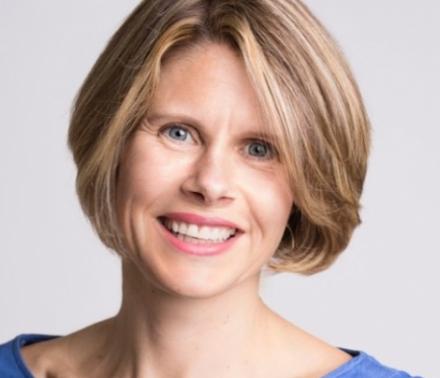Change Agent

For Tanya van Biesen, it was kinda, sorta déjà vu. Two summers ago she left her two-decade-long career as a recruiter to become Executive Director of Catalyst Canada, a not-for-profit organization that advocates for women in the workplace. But even before her first day at Catalyst, the job felt familiar. And for good reason.
A decade earlier, in 2006, Tanya had been a partner in the executive search firm Spencer Stuart. There, she’d been put in charge of finding… you guessed it…an executive director for Catalyst Canada. Tanya was impressed with Catalyst, but it never occurred to her that she’d one day hold the job for which she was recruiting.
But in 2016, when Catalyst head Alex Johnston left for the CBC, the executive director position was open again. Tanya seemed the right person for the job. At Spencer Stuart, she led the company’s diversity practice and was keenly aware that there was a vast pool of talented women out there to fill leadership roles in corporate Canada.
"My biggest priority is to change the conversation around gender equality in Canada from ‘why?’ to ‘how?’ Rather than why should we do it, how do we get there?"
Catalyst’s core mission is to accelerate progress for women through workplace inclusion. One way it does so is to work with corporations directly, bolstering their inclusion policies and helping them advance the careers of their female employees. Another way is through research that shows the benefits of workplace diversity. One of Catalyst’s chief goals is to see more women reach leadership and director roles within companies.
Tanya has her work cut out for her. Although it’s true women now occupy more top posts than they once did, men still dominate the nation’s C-suites. “My biggest priority,” she says, “is to change the conversation around gender equality in Canada from ‘why?’ to ‘how?’ Rather than why should we do it, how do we get there?”
Tanya’s decision to leave one of the world’s top search firms for a non-profit was a big move. But it wasn’t her first unexpected career turn.
Upon graduation from Queen’s Commerce in 1991, many in Tanya’s class sought banking and marketing careers. Tanya, though, was interested in strategy consulting and consumer goods. She accepted a job in sales with Procter & Gamble. “I joined P&G and thought for sure I was going to run the company.”
For the next several years, she ascended P&G’s ranks, holding sales management roles in Toronto and Calgary and a national post with the maker of Tide, Crest, Pampers and other big household brands. But four and a half years in, she thought, “if I never see another tube of toothpaste again, it won't be too soon.”
She began to contemplate her next step. She debated pursuing a master’s degree and a doctorate in French. Interestingly, Tanya, who holds two business degrees — her bachelor’s degree from Smith and an MBA from Rotman — originally wanted to be a French professor.
Born in England, one of three children to Dutch parents, Tanya speaks three languages: English, Dutch and French. She spent her first five years in the Netherlands before her father’s job in the oil and gas industry brought the family to Canada, where they lived in Montreal, Sarnia, ON, and Calgary. “I always loved French, loved languages, and thought I would move to Paris, study there and live there. That was sort of my dream.” It was Tanya’s father who convinced her to take a more “practical” path and enroll in business school.
Tanya’s family also inspired her to explore a career in executive search after she left P&G. “My parents had a small search firm based in Calgary that was oil-patch focused. I knew about the business really from the kitchen table, and I thought, I really like people more than I like inanimate objects like toothpaste and diapers. So why don’t I go into this people business?” she explains. So began her 21-year career in search, the last 11 with Spencer Stuart.

Tanya at Catalyst’s downtown Toronto office, with her colleague and mentee, Alicia Sullivan.
One can see how the executive director opening at Catalyst piqued Tanya’s interest. Still, leaving Spencer Stuart was a tough decision. The move meant a substantial pay cut, and Tanya worried that starting a new career after so long in search might be too difficult.
“I thought, is this going to be the rebound boyfriend after a long marriage?” But the transition turned out to be smoother than expected, she says. Better yet, in her job at Catalyst, Tanya has been able to leverage many of the relationships she made during her executive search days.
Catalyst was founded by Felice N. Schwartz, an American social activist, in 1962. It was the height of the Mad Men era, when women’s careers usually started in the secretarial pool and ended with marriage. Schwartz left work to raise a family, too, but was then frustrated that companies would not hire women like herself when they tried to rejoin the workforce. Educated women, she thought, were bursting with capabilities that companies sorely needed.
Businessmen of the day (and they were men) did not see things Schwartz’s way, of course. But times were changing. A year earlier, a new President, John F. Kennedy, had created a commission on the status of women — the first time a U.S. president had done so. Schwartz asked one of the commission’s architects, Esther Peterson, head of the U.S. Department of Labor’s Women’s Bureau, to join her board. Peterson eventually did, and slowly over the next few decades, Schwartz began to pull business leaders to Catalyst’s side.
Today, Catalyst operates around the world and is supported by more than 800 companies. Its own board of directors comprises executives from a who’s who of blue chip corporations: McDonald’s, Coca-Cola, Morgan Stanley and many more.
Women have come a long way since Felice Schwartz’s day. But in the upper echelons of business, it’s still a man’s world. Canadian companies are no exception. Thirty-nine per cent of TSX-listed companies have no women directors and 38 per cent have no women executive officers. Only 26 per cent of open board positions are filled by females.
Yet evidence shows that gender diversity is good for the bottom line. A recent report by CIBC World Markets found that over an eight-year period to 2016, companies on the S&P/TSX Composite with one or more women on their boards saw average annual returns of 11.1 per cent, compared to 7.4 per cent for companies with no women board members.
Tanya says her priorities are to “amplify Catalyst’s voice” and cut down on “very cluttered noise that exists in the gender space” by working closer with groups that share Catalyst’s message. Two recent examples of this approach are the Catalyst Accord 2022 and the Canadian Gender and Good Governance Alliance, both of which were launched last November.
The Catalyst Accord calls on Canadian businesses to pledge to have 30 per cent of executive and board positions, on average, filled by women by 2022. As of 2016, women held just 15 per cent of executive officer positions on S&P/TSX Composite Index companies and 19 per cent of board seats. Catalyst has offered its services to companies that make the 30 per cent pledge.
The Canadian Gender and Good Governance Alliance, meanwhile, is sort of a super group of non-profits. Members include the Business Council of Canada, the 30% Club, the Institute of Corporate Directors, the Clarkson Centre for Business Ethics and Board Effectiveness, Women in Capital Markets, the Canadian Coalition for Good Governance and, of course, Catalyst.
“In order to achieve a balance of power and participation, we need men to be fully involved in the dialogue and the change.”
One of the alliance’s first initiatives was to develop the “Director’s Playbook”, an online resource to help companies incorporate gender diversity into their boardroom appointment decisions. The playbook has practical suggestions, such as adopting non-zero targets and formal renewal mechanisms (such as term and age limits) for corporate boards, to ensure more fresh faces around the table. Another idea: broaden board-member qualifications. Board-member searches often now favour qualifications such as CEO experience, which are more typically found on men’s résumés than on women’s.
All this activity comes at a historic point in time for women. The #MeToo movement has laid bare widespread sexual harassment in Hollywood and beyond by men in power. In December, Time named the women of #MeToo its Person of the Year. And while Prime Minister Justin Trudeau’s decision to make half his cabinet female may be a positive precedent for others to follow, U.S. President Donald Trump’s often vulgar comments about women seems a depressing step back in time.
Tanya notes that at least 25 per cent of women still face sexual harassment at work. “In order to achieve a balance of power and participation, we need men to be fully involved in the dialogue and the change.” That’s why Catalyst’s work is directed not just at the women inside companies, but also at the men.
While some of Canada’s largest companies — banks and firms like Deloitte and Intact Insurance — have made significant strides in female representation at the executive and board levels, Tanya says progress is slower at small- and medium-sized companies. Perceptions in business can be hard to change quickly, she admits.
“Society’s view of what leadership looks like has a very specific set of characteristics. It’s male, it’s white, it’s someone probably over 60 who has greying hair…It sounds crazy, but these are still cultural norms that we all grew up with and still identify with, even if we’re trying to push ourselves not to identify with them,” she says. “There’s still a lot of work to be done to move from the ‘why’ to the ‘how’ conversation.”
But Tanya remains optimistic, and she hopes to see the day when Catalyst’s efforts truly pay off and the balance of power and participation she’s working toward is finally achieved. “I hope that I’m not dead and gone before that happens.”

